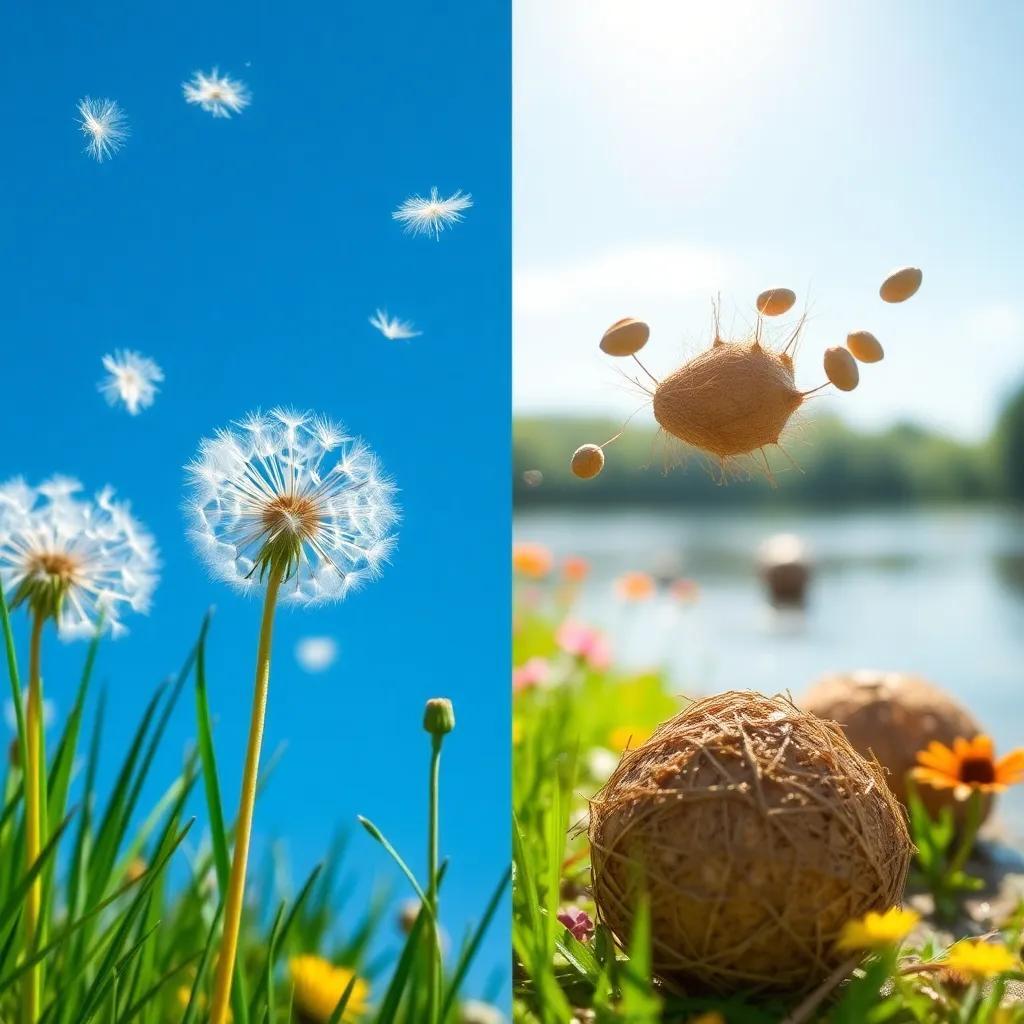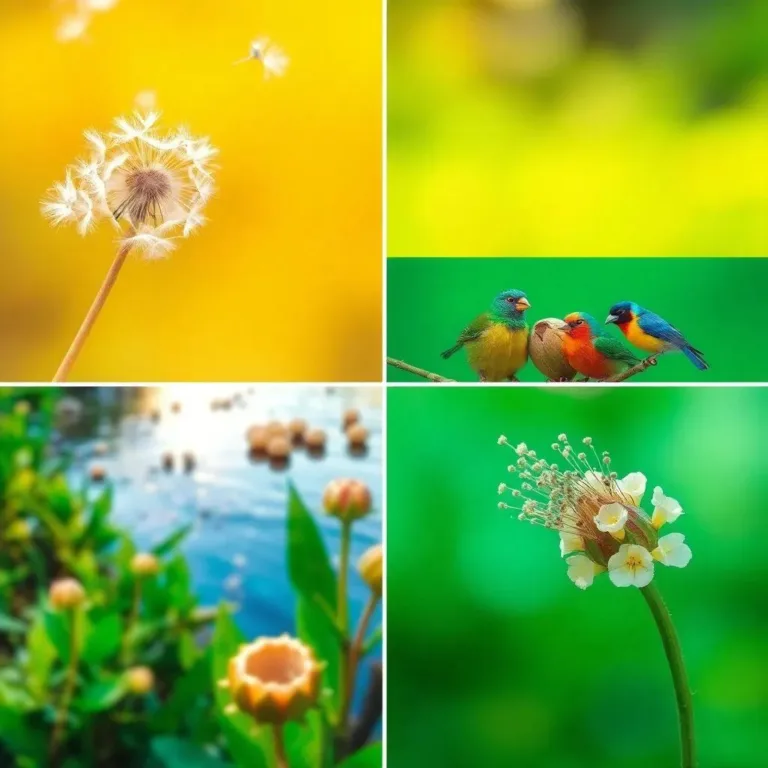Have you ever wondered how seeds find their way to new homes? From flying through the air to floating on water, plants have some amazing tricks up their sleeves to spread their seeds! Join me as we explore the fascinating methods of seed dispersal and discover the clever ways nature helps plants grow and thrive in different places! 🌱✨
Methods of Seed Dispersal: An Overview
When you think about plants, you might picture a garden full of beautiful flowers. But have you ever stopped to think about how those plants spread their seeds? There are several amazing methods that nature uses to help plants grow in new spots! Let’s take a closer look at the different ways seeds can move from one place to another.
- Wind Dispersal: Some seeds are super light and have special features that let them float away with the breeze. Ever seen a dandelion go to seed? Those fluffy little balls are perfect for catching the wind! Plants like maples have seeds with wings that spin as they fall, like a little helicopter.
- Water Dispersal: Other seeds take a ride on water! Aquatic plants have seeds that can float easily. Think about coconuts! These hard-shelled seeds can travel long distances across oceans, thanks to their buoyant shells. When they wash up on a beach, they have a chance to sprout into new palm trees!
- Animal Dispersal: Some seeds get a helping hand (or paw) from animals! Animals eat the fruits, and when they move around or, let’s be honest, go to the bathroom, they drop the seeds in new spots. It’s like a little present for the plant!
- Mechanical Ejection: Ever seen a touch-me-not plant? When its pods are touched, they explode, flinging the seeds far away! This technique uses built-up pressure to send seeds flying, helping them find new homes.
Each method of seed dispersal helps plants spread out, survive better, and even avoid competition with other plants. Isn’t nature clever?
Wind Dispersal: Aerial Strategies for Seed Spread
Let’s take a closer look at the first method: wind dispersal! It’s amazing how some seeds can just float along and travel long distances, thanks to a little help from the wind.
Many plants have evolved to create seeds that are not only light but also designed for flight! Here are some key features that help these seeds soar through the air:
- Wings: Like tiny airplanes, some seeds have wing-like structures. These wings catch the wind and help them glide. Maple seeds are a great example, spinning gracefully as they fall!
- Plumed Tufts: Dandelion seeds have fluffy tufts that act like parachutes. This helps them drift and float far away from the parent plant.
- Small Size: Wind-dispersed seeds are often tiny! The smaller the seed, the easier it is for the wind to carry it off. Who knew being light could be so beneficial?
Plants that rely on wind for seed dispersal usually produce lots and lots of seeds to increase their chances of success. After all, wind can be unpredictable! Some plants can produce thousands of seeds just to make sure a few can find a good spot to grow.
So, the next time you see a dandelion puff in the breeze, give it a little wave and think about how far it might travel! Wind dispersal is a fantastic way for plants to spread their wings—literally! 🌬️

Water Dispersal: Floating Seeds Across Aquatic Landscapes
Let’s splash into the wonderful world of water dispersal! This method is all about seeds that love to float and ride the waves. Plants living near water have some clever tricks up their sleeves to help their seeds travel by water.
Many seeds that use water dispersal are designed to be buoyant. They often have special structures that help them stay afloat, making it easy for them to be carried along by rivers, lakes, or even ocean currents. Here are some amazing features that help these seeds:
- Air-filled cavities: Many water-dispersed seeds have pockets filled with air, which helps them float on the surface of the water. This design is like having tiny life jackets!
- Lightweight structure: These seeds are often smaller and lighter than others, making them easier to transport.
- Protective coatings: Some seeds are wrapped in tough shells or coatings that keep them safe from water damage. This means they can float around without getting soggy!
A great example of water dispersal is the coconut seed. It has a hard shell that protects the seed inside and a fibrous husk that helps it stay afloat. Coconuts can travel great distances over the ocean, just waiting for the perfect beach to wash up on!
Water dispersal is a fantastic way for plants to spread their seeds across different habitats. By floating, they can reach new areas and thrive in places they couldn’t if they stayed put. So, the next time you see seeds floating on the water, just think about the exciting journey they might take!
Animal Dispersal: The Role of Wildlife in Seed Distribution
Now, let’s talk about animal dispersal, which is one of the most fun ways seeds get around! Animals play an important role in helping plants spread their seeds to new places. This method can be broken down into two main types: endozoochory and epizoochory. Let’s explore both!
- Endozoochory: This fancy term refers to seeds that are eaten by animals! When these animals munch on fruits, they also swallow the seeds. But don’t worry! Many seeds can survive their trip through the animal’s digestive system, thanks to their tough outer coats. When the animal walks or flies away and eventually… you guessed it, poops, the seeds are dropped in a new location! This process gives seeds a chance to grow in fresh soil, far away from the parent plant. Birds, like the colorful cedar waxwing, are great seed dispersers because they eat fruits and travel long distances!
- Epizoochory: This method involves seeds that hitch a ride on the outside of animals. Some seeds have hooks, barbs, or sticky surfaces that allow them to cling to the fur or feathers of animals. Think of burrs! When animals roam around, they accidentally drop these seeds in new places. It’s like a little surprise for the plants!
Animal dispersal is a win-win for both plants and animals. While animals get a tasty snack, plants get their seeds spread out, helping them grow in new environments. Next time you see animals eating fruits or find burrs stuck to your clothes, remember how important they are in the seed dispersal party!
Mechanical Ejection: Nature’s Explosive Seed Launchers
Let’s get excited about mechanical ejection, a unique and energetic method of seed dispersal! Some plants have developed incredible ways to launch their seeds into the world, sending them flying far from the parent plant. It’s like nature’s version of a seed cannon!
This method often relies on built-up tension inside the plant. When the pressure reaches just the right point, bang! The seeds are propelled away in an explosive fashion. Here are some cool features of plants that use mechanical ejection:
- Tension-based pods: Plants like touch-me-nots have seed pods that are under tension as they mature. When the pods are disturbed, they burst open, flinging seeds in various directions! It’s like a mini fireworks display!
- Specialized structures: Other plants, like the sandbox tree, have fruit that contains explosive liquids. When these fruits dry out, the pressure builds up until they pop open, shooting seeds at impressive speeds. The sound of the seeds launching can be quite surprising!
- Distance and spread: Mechanical ejection allows seeds to travel a good distance from the parent plant. This reduces competition and increases the chances of successful germination in various locations.
Mechanical ejection is an exciting way for plants to ensure their seeds find new homes. By using explosive force, these plants can disperse their seeds effectively, reaching areas that may be more suitable for growth. So, next time you come across a touch-me-not pod, give it a gentle poke and watch out for the aerial show! 🌱💥

